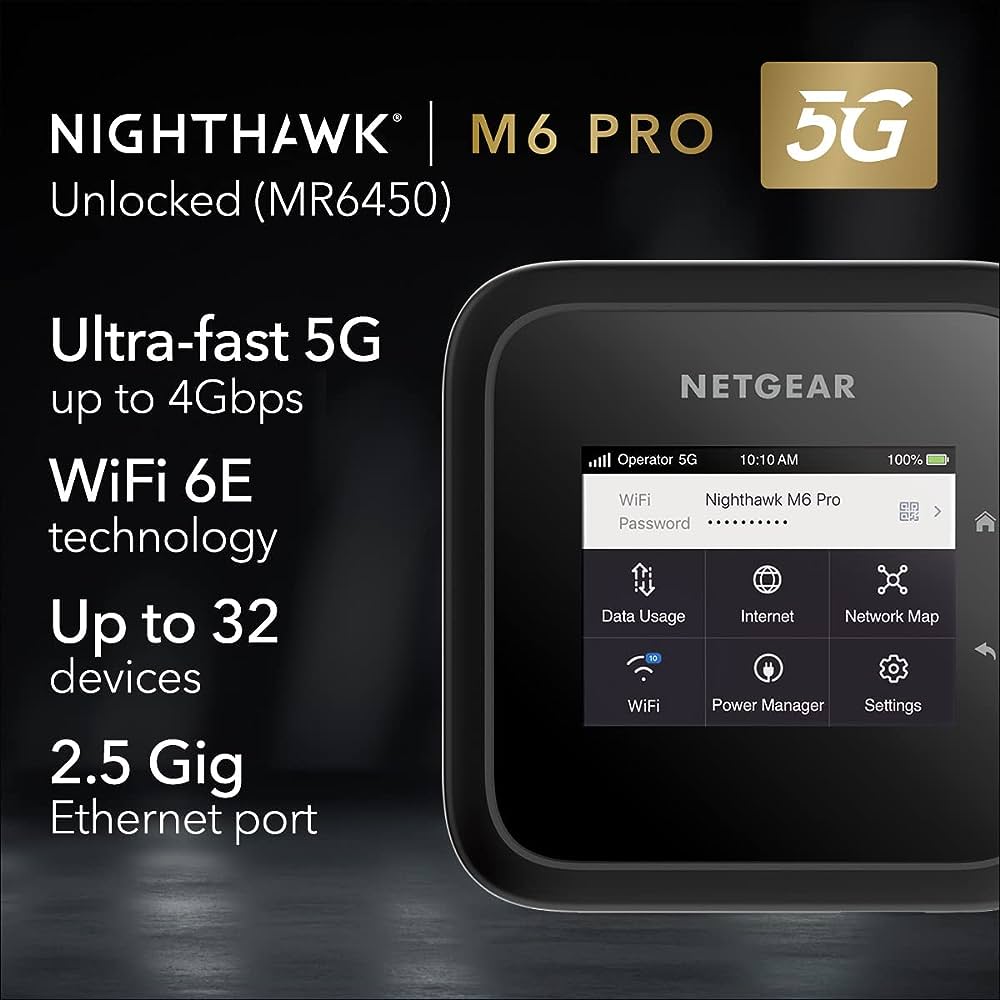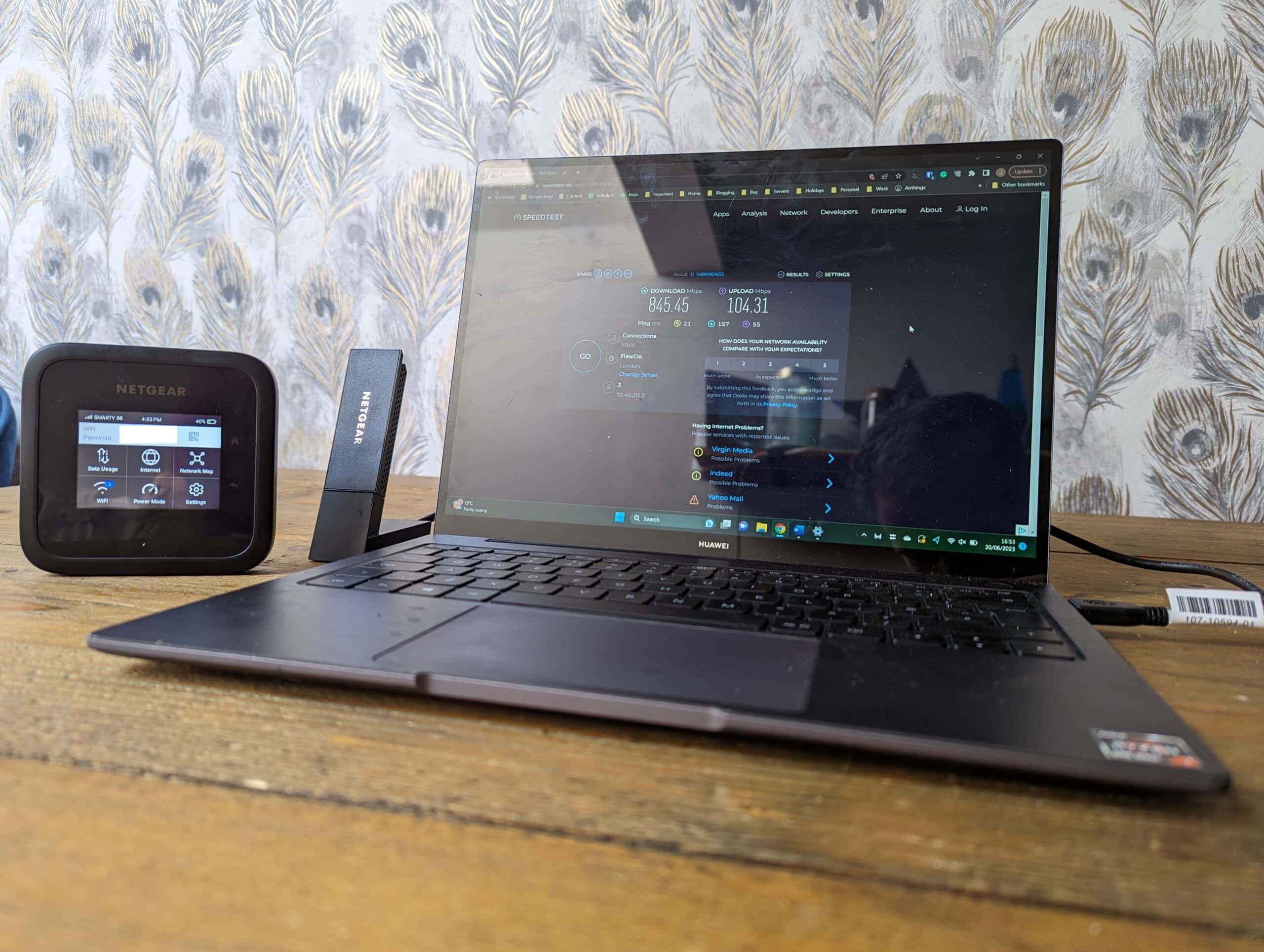Introduced at CES 2023 in January, I’ve finally secured a Netgear Nighthawk M6 Pro (MR6450) for a comprehensive review.
Currently, it stands out as the pinnacle of 5G mobile hotspot routers available. It boasts a plethora of features, including WiFi 6E, a 2.5GbE port, and an unparalleled 5G speed benchmark of 4Gbps that I’ve seen.
However, being top-tier comes with its price. Netgear, recognizing its unparalleled offerings, has set its price at a premium £899.99.
For those seeking an alternative, there’s the M6 (MR6150) variant, equipped with a slightly toned-down 5G specification, WiFi 6, and gigabit Ethernet, priced at £759.99.
Features & Specifications
The Nighthawk M6 Pro is packed with impressive features. It’s a tri-band router, offering one 2.4GHz band and two 5GHz bands. This ensures optimal performance and reduced interference. The router also supports Wi-Fi 6, the latest Wi-Fi standard, which offers faster speeds and improved range.
Furthermore, the M6 Pro is equipped with a 1.5GHz quad-core processor, ensuring smooth performance even under heavy network traffic. It also boasts 512MB of RAM and 512MB of flash storage, providing ample space for firmware updates and other essential functions.
One of the standout features of the M6 Pro is its compatibility with the NETGEAR Nighthawk app. This app allows users to set up their router quickly, monitor network traffic, and even run speed tests.
Netgear Nighthawk M6 Pro Comparison With Nighthawk M5

| Nighthawk | M6 Pro | M5 |
|---|---|---|
| Price | £899.99 | £829.99 |
| Chipset | Qualcomm SDX65 | Qualcomm SDX55 |
| 5G Speed | 4Gbps | 2.1Gbps |
| WIFI 6/WIFI 6E | WiFi 6E | WiFi 6 |
| Max WiFi Speed | 3.6 Gbps 2×2: Up to 700Mbps (20/40MHz) 5GHz or 6GHz 2×2: Up to 2900Mbps (20/40/80/160MHz) 4K QAM | 1.8Gbps 1.2Gbps on 5GHz 600Mbps on 2.4GHz |
| Number of Devices | Up to 32 | Up to 32 |
| Ethernet Port | 2.5 Gig | 1 Gig |
| Display | 2.8″ | 2.4″ |
| Antenna Ports | 2 TS-9 | 2 TS-9 |
| Battery | 5040mAh 13 hours | 5040mAh 13 hours |
| Features | Mobile hotspot/USB cellular modem, Wi-Fi repeater, Wi-Fi router | Mobile hotspot/USB cellular modem |
Netgear Nighthawk M6 Pro vs M6: Hardware specifications
| Netgear | M6 Pro | M6 |
|---|---|---|
| Model | MR6550 | MR6110 |
| 5G Chipset | Qualcomm SDX65 | Qualcomm SDX62 |
| 5G Speed | 8Gbps | 2.5Gbps |
| (up to) | ||
| 5G Technology | Sub 6 and mmWave(9xCA) | Sub 6(2xCA) |
| 4G Speed | 2Gbps | 1.6Gbps |
| (up to) | ||
| 4G Technology | CAT 20 LTE A(5xCA) | CAT19 LTE A(5xCA) |
| Wi-Fi Bandwidth | Dual | Dual |
| Band Wi-Fi 6E AXE3600 | Band Wi-Fi 6 AX3600 | |
| 2.4GHz Specs | 2×2: Up to 700Mbps | 2×2: Up to 700Mbps |
| (20/40MHz) | (20/40MHz) | |
| 5GHz/6GHz Specs | 5GHz or 6GHz | 5GHz only |
| 2×2: Up to 2900Mbps | 2×2: Up to 2900Mbps | |
| (20/40/80/160MHz) | (20/40/80/160MHz) | |
| 4K QAM | 4K QAM | |
| Wi-Fi Security | WPA, WPA2, WPA3 | WPA, WPA2, WPA3 |
| Battery | Removable A5040m | Removable A5040m |
| Battery Life | 13 hours | 13 hours |
| (up to) | ||
| Weight | 0.55 lb (252 g) | 0.55 lb (252 g) |
| (with battery) | ||
| Power Consumption | ≈ 70 Wh | not measured |
| (per 24 hours) | (measured when plugged in, battery removed) | |
| Dimensions (HWD) | 4.14 x 4.14 x .85 in | 4.14 x 4.14 x .85 in |
| (105 x 105 x 21.5 mm) | (105 x 105 x 21.5 mm) | |
| SIM Type | Nano-SIM (4FF) | Nano-SIM (4FF) |
| Network | Unlocked | Unlocked |
| Ports | 1x USB Type-C (charging/data) | 1x USB Type-C (charging/data) |
| 1x 2.5Gbps Ethernet | 1x 2.5Gbps Ethernet | |
| 2x TS9 RF ports (for external antennas — not included) | 2x TS9 RF ports (for external antennas — not included) | |
| USB Standard | USB 3.2 Gen 1 | USB 3.2 Gen 1 |
| (5Gbps) | (5Gbps) | |
| Screen | 2.8” LCD touchscreen interface | 2.8″ LCD touchscreen interface |
| Operating Roles | Mobile hotspot/USB cellular modem, | Mobile hotspot/USB cellular modem |
| Wi-Fi repeater, | ||
| Wi-Fi router | ||
| Networking Features | • Guest Network | • Guest Network |
| • Wi-Fi Protected Setup | • Wi-Fi Protected Setup | |
| • WPS on/off control | • WPS on/off control | |
| • Wi-Fi on/off control | • Wi-Fi on/off control | |
| • Wi-Fi SSID broadcast on/off control | • Wi-Fi SSID broadcast on/off control | |
| • VPN passthrough | • VPN passthrough | |
| • MAC address filtering | • MAC address filtering | |
| • Website filtering | • Website filtering | |
| • Port forwarding | • Port forwarding | |
| • Port filtering | • Port filtering | |
| • Password-protected web admin portal | • Password-protected web admin portal | |
| Max Wi-Fi Clients | 32 | 32 |
Power Modes
This hotspot boasts three distinct power settings. Initially, I brushed them off, assuming they would merely differ in display and sleep functionalities. However, there are marked differences among them.
Balanced – As the default setting, it promises optimal battery life. In this mode, the device primarily serves as a mobile hotspot. The network port remains inactive and is preset to 100Mbps, though it offers the option to activate the Ethernet.
Performance – Tailored for maximum efficiency while on battery. Here, the network port comes alive, initially set to 100Mbps, but with the flexibility to upgrade to gigabit speed.
Plugged in – Designed for peak performance, this mode requires a battery removal followed by a reboot. It potentially boosts the WiFi range, and its network port starts at 100Mbps by default but can be shifted to either gigabit or 2.5Gbps.
In the ‘plugged-in’ setting, the device is particular about its power source. I initially tried a PD USB-C cable, given I have an array of them, but it was declined, urging the use of the original charger. Nevertheless, a USB-A to USB-C cable should suffice, given that the charger meets the voltage requirements.
Radio Band Options
A peculiar limitation of this router is its inability to simultaneously activate all three WiFi bands. You must choose between operating on a singular band or a dual band (either 2.4GHz + 6GHz or 2.4GHz + 5GHz).
This constraint seemingly diminishes the utility of the 6GHz band, given its shorter span compared to 5GHz and the limited devices supporting it. Theoretically, if I am in a setting requiring connectivity for only a WiFi 6E laptop and a phone, the 6GHz band might suffice. However, the hassle of toggling radio modes usually persuades me to stick with the 2.4GHz + 5GHz combo. Given the 160MHz capacity of 5GHz, WiFi throughput likely remains consistent.
It’s essential to clarify that this isn’t an oversight by Netgear. Rather, it’s a constraint of the Qualcomm chipset.
Performance
In terms of performance, the Nighthawk M6 Pro doesn’t disappoint. It offers fast and stable connections, ensuring that users can stream, game, and browse without any hiccups. The tri-band functionality ensures that multiple devices can connect without causing any interference.
In my home, I observed some unusual variations in internet speeds between different rooms. Given that I reside near a water tower equipped with mobile masts, I anticipated a strong signal throughout.
Of all the networks, Smarty (Three) delivered the most commendable performance. In my office, I was initially pleased with a download speed of 348Mbps and an upload rate of 13.33Mbps.
However, when I conducted a subsequent test in my dining room for photographic purposes, the results were even more astonishing. The download speed soared to 686.23 Mbps, while the upload rate slightly dipped to 9.36 Mbps.
While these numbers don’t fully leverage the capabilities of 5G and the hotspot device, a 600Mbps download speed is undeniably sufficient for even the most intensive users. An enhanced upload speed, however, would have been the cherry on top.
Intriguingly, the speed I registered was swifter than when I utilized the hotspot with the WiFi/Ethernet offloading feature.
WiFi Offloading
In its WiFi offloading mode, the M6 Pro seamlessly connects to an available WiFi network, prioritizing it as the main connection. Meanwhile, mobile data stands as a backup should the WiFi falter.
This mode offers several benefits when you link the M6 Pro to a public WiFi:
- Streamlined Connection: Instead of manually connecting each of your devices to the network, just connect the M6 Pro.
- Enhanced Security: On the public network, only the M6 Pro will be discernible, safeguarding all your other devices.
- Potential Cost-Saving: Suppose you’re at a location, like certain hotels, that levy charges based on the number of devices connected to their WiFi. In that case, the M6 Pro could offer financial savings, although it’s worth noting that most modern hotels now offer complimentary WiFi.
For initiating WiFi offloading, you have the flexibility of using the router’s touchscreen interface or the browser-based interface. Post-reboot of the router, you’d be required to access the web interface and choose the SSID to which you’d like to connect.
It’s noteworthy that during WiFi and Ethernet offloading, the router’s local IP might differ, especially if, for instance, your home network is configured on 192.168.1.x. For easy access, you can also navigate using mywebui.net.
Ethernet Offloading / As a WiFi Router
Ethernet offloading mirrors the function of WiFi offloading. Essentially, you’re transforming the M6 Pro into a WiFi router while retaining the mobile data as a backup connectivity option.
When opting for this method, it’s imperative to adjust the M6 Pro’s power settings. Initially, I faced some puzzling moments, noticing speeds of only 100Mbps, even though my internet package boasts a gigabit connection.
In the ‘balanced’ setting, your speed caps at 100Mbps, despite enabling the Ethernet port. For maximizing your connectivity, switch to the ‘performance’ mode to unlock gigabit speeds, or use the ‘plugged-in’ setting to tap into the potential of 2.5GbE.
This setup is especially handy in hotels equipped with in-room Ethernet connections. Not only does it fortify device security and diminish setup duration, but it also paves the way for potential savings if the establishment charges per device connection.
Performance Analysis for WiFi & Ethernet Offloading
In my tests for both WiFi and Ethernet offloading, the results fell short of my anticipated speeds. My optimum result was achieved when the hotspot was set to the maximum performance mode, plugged in, and 2.5GbE activated.
Under these conditions, I managed to register speeds of 630Mbps for downloads and 104Mbps for uploads. Ideally, given its ability to connect at 2400Mbps, it should have matched, if not surpassed, my internet package’s capacity, which is Virgin Media’s 1Gbps offering.
Conclusion
The Nighthawk M6 Pro (MR6450) is a market-leading product in the world of mobile hotspots. With its impressive specifications, performance, and features, it’s a product that’s worth considering for anyone in the market for a new hotspot. Whether you’re a gamer, a streamer, or just someone looking for a reliable internet connection, the M6 Pro is sure to deliver.

